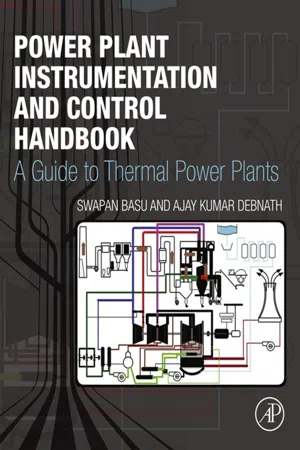
Power Plant Instrumentation and Control Handbook
A Guide to Thermal Power Plants
Swapan Basu,Ajay Kumar Debnath
- 942 pagine
- English
- ePUB (disponibile sull'app)
- Disponibile su iOS e Android
Power Plant Instrumentation and Control Handbook
A Guide to Thermal Power Plants
Swapan Basu,Ajay Kumar Debnath
Informazioni sul libro
The book discusses instrumentation and control in modern fossil fuel power plants, with an emphasis on selecting the most appropriate systems subject to constraints engineers have for their projects. It provides all the plant process and design details, including specification sheets and standards currently followed in the plant. Among the unique features of the book are the inclusion of control loop strategies and BMS/FSSS step by step logic, coverage of analytical instruments and technologies for pollution and energy savings, and coverage of the trends toward filed bus systems and integration of subsystems into one network with the help of embedded controllers and OPC interfaces. The book includes comprehensive listings of operating values and ranges of parameters for temperature, pressure, flow, level, etc of a typical 250/500 MW thermal power plant. Appropriate for project engineers as well as instrumentation/control engineers, the book also includes tables, charts, and figures from real-life projects around the world.
- Covers systems in use in a wide range of power plants: conventional thermal power plants, combined/cogen plants, supercritical plants, and once through boilers
- Presents practical design aspects and current trends in instrumentation
- Discusses why and how to change control strategies when systems are updated/changed
- Provides instrumentation selection techniques based on operating parameters. Spec sheets are included for each type of instrument
- Consistent with current professional practice in North America, Europe, and India
Domande frequenti
Informazioni
Introduction
Abstract
Keywords
Power Plant Hand Book; Heat & Work; Laws of Thermodynamics; Rankin cycle; Enthalpy; Entropy; Steam & Gas Turbine1. Introduction
2. Fundamental Knowledge about Basic Process
2.0. Ideas within and Outside the System
2.0.1. Zeroeth Law of Thermodynamics
2.0.1.1. Energy
Indice dei contenuti
- Cover image
- Title page
- Table of Contents
- Copyright
- Dedication
- Foreword
- Preface
- Acknowledgments
- Chapter I. Introduction
- Chapter II. Main Equipment
- Chapter III. Plant P&ID Discussions
- Chapter IV. General Instruments
- Chapter V. Special Instrument
- Chapter VI. Final Control Element
- Chapter VII. Intelligent Control System
- Chapter VIII. Boiler Control System
- Chapter IX. Turbo Generator Control System
- Chapter X. Coordinated Control System
- Chapter XI. Balance of Plant Control System
- Chapter XII. Installation Practices
- Appendix I. Process and Mechanical Standard Table
- Appendix II. Electrical Data and Tables
- Appendix III. ISA Standard, Materials, Human Engineering, and Control Room
- Appendix IV. Network Control and Communication
- Appendix V. Super/Ultra Super Critical Power Plants
- Appendix VI. Integrated Gasifier and Combined Cycle Plant (Pollution Control)
- Appendix VII. A Few Operational Features of the Unit
- Index